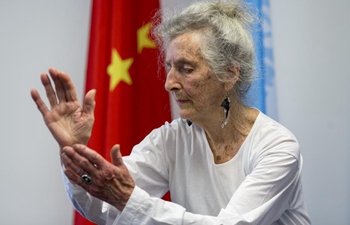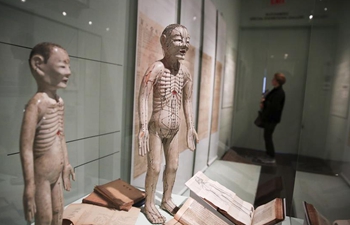HAVANA, April 26 (Xinhua) -- Almost 90 years after it first opened, Havana's iconic Capitol building has been restored to its original splendor as it recently began to function as the National Assembly after a mammoth renovation project.
Inaugurated in May 1929, the colossal Capitolio was built to house the Congress, which was abolished following the Cuban Revolution in 1959. The building had since then hosted the Academy of Sciences for five decades.
Today, following six years of meticulous restoration work, it has regained its sense of historic purpose, housing the administrative offices of the National Assembly, Cuba's legislature which just a week ago elected the country's new president, Miguel Diaz-Canel.
"This is the first time the building has been restored since it opened. Some specific repairs have been made (before), but this is the first full renovation," Mariela Mulet, chief executive of investments at the Capitol, told Xinhua.
The building was declared a national monument in 2010 and handed over to the Havana Historian's Office, which immediately launched the costly renovation effort.
"About 90 percent of the materials used to restore the building were imported, making it expensive and difficult for us," Mulet said.
More than 500 people participated in the massive project.
Mulet and her team decided to undertake the restoration in stages, prioritizing the repair of all the roofs, interior yards and the facade, which was severely damaged by the passage of time.
Inspired by the Pantheon in Paris, St. Peter's Basilica in Rome and the U.S. Capitol in Washington, D.C., the building has been given many striking features, including a monumental 36-meter-wide granite staircase flanked by two bronze statues made by an Italian artist.
Walking in, visitors are met by a magnificent statue that represents the republic. Almost 20 meters high and weighing 49 tons, it is considered the third largest indoor sculpture in the world, after the Golden Buddha of Nara in Japan, and the Abraham Lincoln Memorial in Washington.
Carved in bronze, laminated in gold and standing on a solid base of Egyptian onyx marble, the sculpture stands guard at the entrance to a 120-meter-long hallway called "the Hall of the Lost Steps."
Overhead is the Capitol's dome. Being 91.7 meters in height, it was the fifth tallest in the world at the time of the building's inauguration.
One of the most popular and solemn places in the building is the tomb of the unknown independence fighter, a crypt dedicated to those who fought for independence from Spanish colonialism in the 19th century and a symbol of the democratic spirit of the Caribbean nation.
The north wing was opened to the public in March, with guided visits becoming an attraction for locals and foreigners alike, but there is still work to be done, said Marisol Marrero, general designer of the restoration work.
"The most difficult task has been to conserve the delicacy with which this building was built and at the same time install modern technological systems like surveillance, alarms, air conditioning, Internet and communications without doing damage," said Marrero.
The challenge was overcome thanks to the expertise and dedication of the contractors, she said.
"It has been a good professional experience because we've had to invent solutions, like concealing or hiding air conditioning pipes inside the walls in order to maintain the original decoration of the premises," she said.
The Capitol is expected to be fully renovated by November 2019, in time to mark the 500th anniversary of the founding of Havana.













